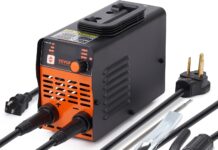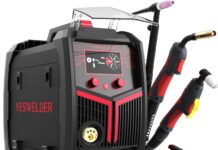When it comes to welding machines, one vital feature that often gets overlooked is the duty cycle. But what exactly is the duty cycle? In simple terms, it refers to the amount of time a welding machine can be operated without overheating. Understanding the duty cycle is essential as it helps you determine the machine’s productivity and longevity. In this article, we will delve into the intricacies of the duty cycle on a welding machine, shedding light on its importance and how it impacts your welding projects. So, whether you’re a seasoned welder or just starting out, sit back and let us demystify the duty cycle for you!
What is the duty cycle on a welding machine?
Definition of duty cycle
The duty cycle on a welding machine refers to the amount of time within a specified period that the machine can operate before it needs to cool down. It is expressed as a percentage and represents the ratio between the welding time and the cooling time.
Importance of duty cycle in welding
Understanding the duty cycle is essential for welders as it determines the machine’s capacity to handle continuous welding operations. Welding machines generate a significant amount of heat during operation, and without allowing adequate time for cooling, they can overheat and potentially cause damage. By knowing the duty cycle of a welding machine, welders can effectively manage their workloads and prevent overheating issues.
Understanding the rating system
The duty cycle is indicated by a rating number, followed by a percentage. For example, a machine with a duty cycle rating of 60% means that it can weld continuously for six minutes out of a ten-minute period. The remaining four minutes are reserved for cooling down the machine. It is important to note that high-duty cycle ratings typically come with a higher price tag, as they indicate a machine’s ability to perform for extended periods without overheating.
Factors affecting the duty cycle
Several factors can influence the duty cycle of a welding machine. One key factor is the machine’s cooling mechanism. Welding machines may employ various cooling methods, such as fans or cooling systems, which impact their ability to dissipate heat efficiently. Additionally, the machine’s power source, output rating, and overall design can also affect its duty cycle. Higher-quality machines often feature better cooling systems and designs that allow for more extended periods of operation.
Calculating the duty cycle
Calculating the duty cycle of a welding machine is relatively straightforward. It involves dividing the welding time by the sum of the welding time and the cooling time, and then multiplying the result by 100. For example, if a machine is capable of welding for eight minutes and needs a cooldown period of two minutes, the duty cycle would be calculated as follows:
(8 minutes / (8 minutes + 2 minutes)) x 100 = 80% duty cycle
Interpreting duty cycle specifications
When observing duty cycle specifications for welding machines, it is important to understand that the rating represents continuous welding under ideal conditions. In real-world welding scenarios, the duty cycle might be lower due to factors such as ambient temperature, extended arc-on times, or using a machine above its rated output. It is crucial to consider these variables, especially if working in high-heat environments or engaging in demanding welding applications.
Choosing the right duty cycle for your needs
Selecting the appropriate duty cycle for your welding needs is crucial to ensure efficiency and reliability. Higher-duty cycle machines are well-suited for professional or industrial applications where extended periods of continuous welding are required. However, if you’re a hobbyist or occasional welder, a lower-duty cycle machine may suffice and provide cost savings. It is essential to evaluate your typical welding workload and match it with a welding machine that can handle the necessary duty cycle without compromising performance or risking overheating.
Increasing duty cycle
While it is not possible to directly increase a welding machine’s duty cycle, there are strategies and practices that can help manage and optimize its usage. One effective method is to spread out the welding workload over multiple machines or using multiple welding setups. By rotating between machines or allowing sufficient cool-down time between welding sessions, you can effectively increase the overall duty cycle. Additionally, employing effective cooling techniques and maintaining proper machine maintenance can also contribute to maximizing a machine’s duty cycle.
Managing duty cycle limitations
Understanding and managing duty cycle limitations are essential to prevent overheating and ensure the longevity of a welding machine. Avoiding continuous welding for prolonged periods beyond the machine’s duty cycle rating is crucial to prevent overheating and potential damage. It is also essential to monitor the machine’s temperature during operation, utilizing cooling mechanisms, such as fans or cooling systems, and allowing sufficient cool-down periods. Regular cleaning, maintenance, and timely repairs are equally important in managing duty cycle limitations and extending the machine’s lifespan.
Common misconceptions about duty cycle
There are a few common misconceptions about duty cycle that should be clarified. Firstly, a higher-duty cycle does not necessarily equate to better overall performance. While higher-duty cycle machines can handle more extended periods of continuous welding, they may come at a higher cost and might not be necessary for all welding applications. Additionally, it is important to note that duty cycle ratings are based on ideal conditions and may vary in real-world situations. Factors such as ambient temperature, arc-on times, or exceeding the machine’s rated output can impact the actual duty cycle achieved.
In conclusion, understanding the duty cycle on a welding machine is crucial for welders to effectively manage their workloads, prevent overheating issues, and ensure the longevity of their equipment. By comprehending the duty cycle rating system, calculating the duty cycle, and interpreting specifications, welders can make informed decisions when choosing the right welding machine for their needs. Moreover, implementing strategies to increase the duty cycle and managing its limitations through proper maintenance and cooling techniques are essential practices in maximizing the efficiency and performance of welding machines.






































